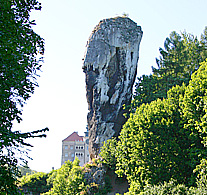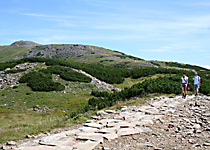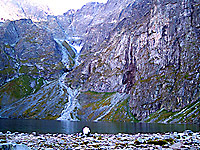National Parks of the Malopolska Province around Krakow
The
Malopolska province, whose capital city is
Krakow, boasts six national parks – more than any other
of Poland’s remaining fifteen administrative regions. All of the
Malopolska national parks lie in a 150-kilometers radius around
Krakow, most of them in the Carpathian Mountains south of the city.
The nearest national park, Ojcowski Park Narodowy, stretches just 18
kilometers north from central Krakow while the most distant of the
six, Magurski Park Narodowy, is a two-hour drive from Krakow.
Two of the Polish national parks situated in the Malopolska
province, Tatry National Park and Babia Gora National Park,
constitute the UNESCO’s World Biosphere Reserves.
Poland’s national parks near Krakow
Please note that distances are measured by road from the center of
Krakow to the boundary of each national park.
About
18 km north of Krakow by road. Area: 21.5 square kilometers,
including 385 hectares of the strict nature reserve. Gateways: towns
of Ojcow in the center of the Ojcowski national park and Skala near
its northeast corner. Highest elevation: Gora Chelmowa 472 meters
above sea level. Geography and geology: the park is part of the Jura
Krakowsko-Czestochowska, a rolling upland made of Jurassic
limestone. Main attractions: Pieskowa Skala castle, rock formations,
caves, ruins of the Ojcow castle.

The Ojcow National Park's trademark 25-m-tall "Hercules' Bludgeon" rock
by the Pieskowa Skala Castle
The Ojcow National Park has been established in 1956 to protect
scenic valleys of two small rivers, Pradnik and Saspowka. Named
after the town of Ojcow that sits in its middle, the park can boast
about 6,000 animal species (even if insects inflate the number
substantially) and up to 1,000 plant species. Bird-watchers may
expect sightings of 134 species of birds such as hawks, woodpeckers,
owls, kingfishers, and herons. But the Ojcow National Park takes the
greatest pride in its 15 species of bats whose colonies inhabit many
of the park’s 400 or so known caves. There are efforts to
reintroduce beavers into the park.
The Ojcow National Park is very popular with the residents of Krakow
mostly for its spectacular scenery marked by ravines and unusual
rock formations, ancient monuments, and several caves accessible to
the general public.
Gorczanski Park Narodowy /Gorce National Park/
65 km south of Krakow by road. Area: 6,744 hectares including 2,420
hectares of three strict nature reserves. Gateways: villages of
Poreba Wielka, Lubomierz, Lopuszna, and Ochotnica Gorna. Highest
elevation: Kiczora 1,282 meters above sea level. Geography: The
Gorce national park covers most of the Gorce range – though its
highest peak Turbacz, 1,310 meters above sea level, is situated
slightly beyond the park’s limits – of the Beskid Mountains, the
northern edge of the Carpathian Mountains. Main attractions: vistas,
primeval forests.
The Gorce National Park has been established in 1981 to preserve
relics of the Carpathian primeval forest. Woods take up 95 percent
of its area and many beech trees and pines are 300 years old. Local
fauna includes deer, lynx, zbik (Felis silvestris, wild cat),
and ermine but the Gorczanski national park has chosen salamandra
plamista (fire salamander, Salamandra salamandra), Poland’s
biggest caudate amphibian, as its hallmark.
Babiogorski Park Narodowy /Babia Gora National Park/
85 km southwest of Krakow by road. Area: 1,734 hectares including
1,061 hectares of strict nature reserve; 943 hectares of forests.
Gateways: village of Zawoja, Krowiarki or Przelecz Lipnicka pass
(road 957). Mountain hostel at Markowe Szczawiny. Highest elevation:
Babia Gora – Diablak peak 1725 meters above sea level. Geography:
the Babiogorski national park covers the summits and northern slopes
of Babia Gora, the highest massif of Beskid Mountains which form the
northern rim of the Carpathian Mountains, the park adjoins the
border of Slovakia. Main attractions: vistas, forests, climbing.

The Babia Gora National Park has been established in 1954 on the
area protected since 1934. In 1977 the UNESCO listed it as a World
Biosphere Reserve. The park can boast around 700 species of
flowering plants plus 200 or so species of mosses, about 200 species
of lichens, and roughly 100 species of algae. The flora of the Babia
Gora National Park make up distinct belts related to climatic zones
changing with altitude – mixed forests at the bottom, followed by
spruce woods, next belt of dwarf mountain pines, then alpine
grasses, and lastly bare rock with sparse vegetation. The park’s
animal species include lynx, bear, wolf, deer, and grouse.
The park is very popular with weekend trekkers thrilled to conquer
the Babia Gora craggy peak and hiking trails are rather crowded in
summer. Several rough mountain tracks lead to the top including
famed Perc Akademikow that gives a taste of truly alpine
mountaineering.
Tatrzanski Park Narodowy /Tatry National Park/
100 km south of Krakow by road. Area: 21,164 hectares including
11,514 hectares of strict nature reserves. Gateways: town of
Zakopane, villages of Koscielisko, Bukowina Tatrzanska,
and Kiry, car park at Palenica Bialczanska (road 960). Mountain
hostels: Morskie Oko, Polana Chocholowska, Hala Kondratowa, Dolina
Pieciu Stawow Polskich, Dolina Roztoki, Hala Ornak, Murowaniec (Hala
Gasienicowa). Highest elevation: Rysy summit 2499 meters above sea
level. Geography: the Tatrzanski national park covers the Polish
part of Tatry Mountains,
group of rugged ranges 60 kilometers long and 16 kilometers wide,
the highest part of the entire Carpathian Mountains; the park
borders on Slovakia’s counterpart, Tatranski Narodny Park (TANAP).
Main attractions: mountaineering and trekking, skiing, alpine
scenery, cable car to the top of Kasprowy Wierch mountain (1987
meters above sea level).

Czarny Staw lake in the Tatry Mountains
National Park
Tatra Mountains National Park has been established in 1954 on the
area protected since 1937. In 1992 the UNESCO proclaimed it the
Tatry International Biosphere Reserve together with the adjacent
Tatranski national park of Slovakia. The flora of Tatry National
Park consists in nearly 2,000 species of plants, including 91
endangered species, some endemic to the Tatra Mountains. The park’s
vegetation form belts, typical for high mountains, that match
changing climate conditions at different altitudes. Mixed forests
reach to about 1200 meters above sea level, spruce woods up to 1550
meters or so, belt of dwarf mountain pines up to roughly 1800
meters, alpine grasses to about 2300 meters, and next bare rock with
sparse vegetation.
Distinctive plants of the Tatra National Park include limba (stone
pine, Pinus cembra) and szarotka (edelweiss,
Leontopodium alpinum), and many travel to the park in springtime
to see its meadows covered with wild crocuses.
The Tatry Mountains National Park boasts 53 species of mammals
including one endemic rodent (polnik tatrzanski), 101 species of
birds, three species of reptiles, seven species of amphibians, and
six species of fish. The park’s emblematic animals are swistak
(marmot, Marmota marmota) and kozica (chamois, Rupicapra
rupicapra). Also, its fauna includes brown bear, lynx, deer, and
wolf. Birdwatchers may hope for sightings of orzel przedni (golden
eagle, Aquila chrysaetos).
The Tatry National Park also preserves spectacular landscapes
typical of high mountains with sharp peaks, sheer cliffs, moraines,
glens, chimneys, gullies, screes, etc. Plus streams, waterfalls
(highest Wielka Siklawa, nearly 70 meters), tarns and lakes (largest
Morskie Oko – 34.9 hectares, deepest Wielki Staw Polski – 79.3
meters). Also caves.
Hiking and trekking trails in the Tatry National Park total 250
kilometers. Most popular destinations are Morskie Oko lake, Giewont
peak, and valleys Dolina Koscieliska and Dolina Chocholowska.
Pieninski Park Narodowy /Pieniny National Park/
105 km SSE of Krakow by road. Area: 2,231 hectares including 777
hectares of strict nature reserves. Gateways: towns of Szczawnica
and Kroscienko, villages of Niedzica, Czorsztyn, and Sromowce Wyzne.
Highest elevation: Trzy Korony peak 982 meters above sea level.
Geography: the Pieninski national park takes up most of Pieniny
range in the Carpathian Mountains on the left, Polish bank of
Dunajec river (the opposite riverbank belongs to Slovakia). Main
attractions: scenic vistas, hiking and trekking, rafting.
The Pieniny National Park has been established in 1954 in the area
protected since 1932. It boasts surprising richness of flora and
fauna. Some 13,000 animal species live within its borders, half of
the total number of species that exist in Poland. Among them are
1,550-plus species of butterflies. The park’s most noteworthy
mammals are lynx and zbik (Felis silvestris, wildcat). Also
birds such as orzel przedni (golden eagle, Aquila chrysaetos),
eagle owl, and thrush nagorniak skalny.
The Pieniny National Park consists in mixed forests and vast
meadows. Their rich flora includes 30 species of wild orchids.
Landscape of the Pieninski national park is marked by sheer
limestone crags piling up on gentle slopes. Most impressive are
cliffs of Dunajec Gorge where the river meanders in seven curves for
eight kilometers between rock walls that rise up as high as 300
meters to 500 meters.
In summer rafting through the Dunajec Gorge attracts vast crowds. To
the west the Pieniny Mountains National Park borders on the Jezioro
Czorsztynskie artificial lake, a major recreational area in the
region. There are two medieval castles on its banks, Niedzica and
Czorsztyn, both situated within the limits of the Pieniny park.
Ruins of another castle sit near the top of Zamkowa Gora (Castle
Mount) in the eastern part of the park.
Magurski Park Narodowy /Magura National Park/
130 km southeast of Krakow by road. Area: 19,439 hectares including
2,408 hectares of strict nature reserves. Gateways: villages of
Krempna, Swiatkowa Wielka, Wapienne, Brzezowa, Mrukowa, Grab,
Olchowiec, Bartne, and Folusz. Highest elevation Watkowa 845.9
meters above sea level. Geography: the Magurski national park is
located on both banks of the Wisloka river in the Magura Ranges (Pasma
Magurskie) of the Beskid Niski Mountains, part of the Carpathian
Mountains. The park adjoins Poland’s border with Slovakia and most
of its area, roughly ninety percent, lies in the Podkarpackie
province while the northwest corner belongs to Malopolska. Main
attractions: hiking, wooden architecture.
The Magura National Park has been established by the end of 1994.
Mixed forests cover 1,8572 hectares of it, meadows and brush amount
to 830 hectares, and about 38 hectares are taken up by
watercourses.
The flora of the Magura National Park consists of 767 species of
vascular plants including 59 strictly protected species, 11
partially protected species, and twelve species registered in the “Red
List of Endangered Plant Species in Poland”.
The park boasts 57 species of mammals such as lynx, wildcat zbik (Felis
sylvestris), wolf, elk (Alces alces), beaver (Castor
fiber), river otter (Lutra lutra), badger (Meles meles),
red deer (Cervus elaphus), roe deer (Capreolus capreolus),
fox (Vulpes vulpes), pine marten (Martes martes),
beech marten (Martes foina), European polecat (Mustela
putorius), ermine (Martes erminea), and weasel (Martes
nivalis).
There are 117 species of birds breeding in the Magurski national
park including buzzard (Buteo buteo), lesser spotted eagle (Aquila
pomarina), sparrowhawk (Accipiter nisus), golden eagle (Aquila
chrysaelos), eagle owl (Bubo bubo), tawny owl (Strix
aluco), long-eared owl (Asio otus), pygmy owl (Glaucidium
passeinum), great spotted woodpecker (Dendrocopos major),
black woodpecker (Dryocopus martius), white-backed woodpecker
(Dendrocopos leucotos), three-toed woodpecker (Picoides
tridactylus), kingfisher (Alcedo atthis), little ringed
plover (Charadrius dubius), sandpiper (Actitis hypoleucos),
dipper (Cinclus cinclus), grey wagtail (Motacilla cinerea),
raven (Corvus corax), black stork (Ciconia nigra),
corncrake (Crex crex), quail (Coturnix coturnix), and
red-backed shrike (Lanius cullorio), plus over 20 migrant
birds.
Also, the park is inhabited by 10 species of amphibians, 6 species
of reptiles, and 12 species of fish.
There are 85 kilometers of hiking trails in Magura National Park
that mostly run through rolling hills. Apart from landscape and
nature points of interest consist mostly in the village’s wooden
architecture of the Orthodox churches.
|
With its mere 21.5 sq. km
it may be the smallest of Poland’s twenty national parks,
but the Ojcow National Park ranks among the most attractive
recreational areas in Europe, and it is just a 15 minutes’
drive–i.e. 24 km–northwest of Krakow.
Krakow's Wildlife
Krakow Geography
Krakow Environment
Downtown green oasis boasts some 5,000 plant species.
Krakow's Blonia Commons
A vast expanse of grassland in downtown Krakow, called
Blonia, is protected by law as the national heritage.
Krakow Weather
Walks
The best way to enjoy Krakow
is on foot.
Tours
In
Krakow and beyond. |





